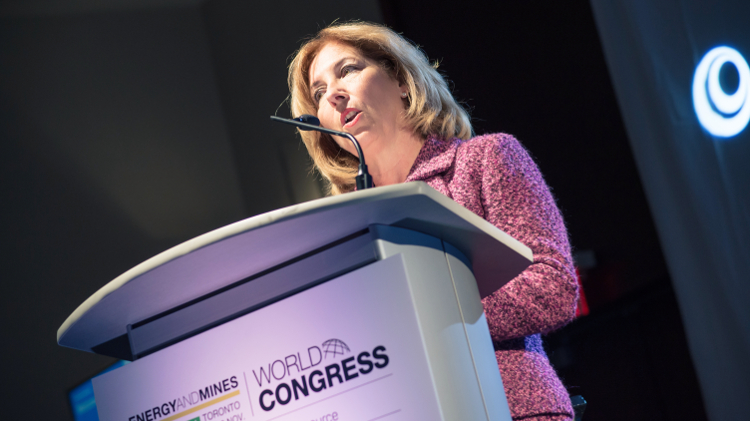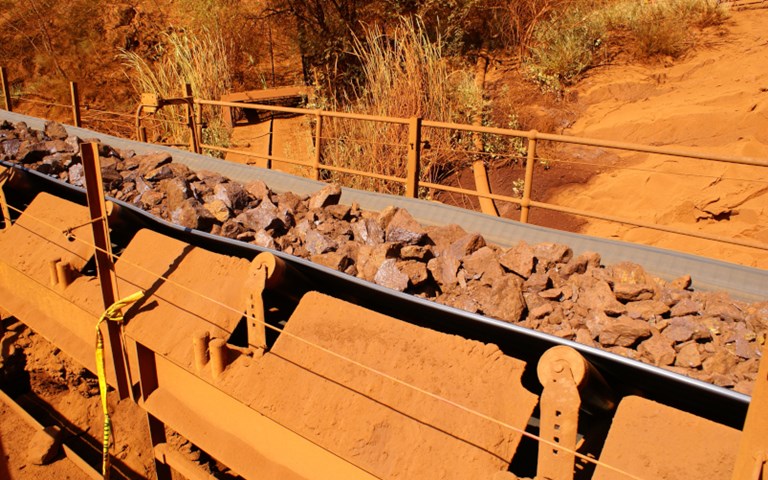In order to meet their net-zero targets mining companies are going to have to take a chance on unproven technologies and turn to existing – but not commonly implemented – technologies like ore sorting. Courtesy of Stantec
Newmont Corp.’s Tanami mine in Australia and its Cripple Creek & Victor (CC&V) operation in Colorado are two very different mines. Tanami, an underground operation, has decades of life ahead of it and has attracted major investment dollars from Newmont for a new shaft; the surface CC&V mine, meanwhile, has a much more limited mine life after a decades-long production run.
But each, in its own way, is the perfect place for a partnership between Newmont and Caterpillar Inc., to develop and test battery-electric surface and underground fleets. The agreement, signed last year, saw Newmont make a US$100 million initial investment towards developing a “zero-carbon-emitting end-to-end mining system” with Caterpillar, including electric mine vehicles, infrastructure, automation and data collection and analysis.
Tanami will give the equipment giant the proving grounds for underground battery-electric technology, which it does not currently have, and its decades-long mine life grants Newmont the flexibility to experiment with new mine designs that accommodate electric infrastructure.
At CC&V, meanwhile, Caterpillar will get to test its battery-electric surface haul trucks in tough weather conditions – from sweltering summers to frigid winters, torrential rain to high winds. “If the technology works there, it’s proven categorically,” said Rob Atkinson, Newmont’s executive vice-president and chief operating officer. For Newmont, Atkinson explained, the benefits at CC&V are proving to the industry that there is a strong economic case for rolling out BEVs, even for a long-existing and mature mine.
The companies are targeting an underground electric and automation rollout by 2026, and above-ground electric trucks and infrastructure by 2027. Atkinson said the development timelines are aggressive, but Newmont felt an imperative to be part of fast-tracking these vehicles.
“We recognize we can’t wait to act, we’ve got to do something absolutely tangible,” said Atkinson, who noted roughly 40 per cent of the company’s emissions come from its surface and underground fleets.
To reach their net-zero goals, mining companies are having to go against the industry-wide preference for being “first to be second” and plan to integrate technologies and processes that are not yet widely adopted or even commercially available.
“We’re really at a turning point in the industry now. It’s not about why we’re doing this but about how,” said Brian Mashford, senior vice-president of mining for Stantec. “We’re seeing a lot of requests to help clients figure out how to implement technologies and become more comfortable with where things are going to be downstream.”
Mashford sees battery-electric fleets for open-pit operations and hydrogen-powered vehicles, small modular nuclear reactors (SMRs), autonomous modular haulage, and ore sorting as just some of the technologies that will have important future roles in net-zero mining, but he acknowledges that companies are still grappling with how to implement them.
In the pilot seat
In the past year, numerous mining companies have announced partnerships or consortiums with original equipment manufacturers (OEMs) and suppliers to fast-track the development of battery-electric or hydrogen fleets, and pilot vehicles as they become available.
In June 2021, Montreal-based Nouveau Monde Graphite (NMG) announced a collaboration agreement with Caterpillar to develop a zero-emissions fleet for its flagship Matawinie mine by its fifth year of commercial production. Matawinie, which is slated to be operational by 2025, will first begin operations with a diesel fleet, and receive new electric equipment from Caterpillar over the subsequent years. Eric Desaulniers, NMG’s founder, president and CEO, said this timeline will allow the company to gradually test and insert the new vehicles into production, and measure their key performance indicators against the existing diesel fleet.
Teck Resources, meanwhile, has committed to testing a Caterpillar pre-commercial zero-emissions vehicle (ZEV) starting in 2024 at its steelmaking coal mines in the Elk Valley, but not in a production capacity, said public relations manager Chris Stannell. The company expects to begin production testing a small fleet of pilot ZEVs by 2026, with the goal to start deploying 30 commercially available trucks the following year.
Stannell said the company will be looking at metrics like speed on grade, component life and mechanical availability, as well as battery-electric powertrain metrics such as charge rate and energy efficiency. “The core objective of the testing will be to understand the scale of opportunity to displace the diesel fleet in operations by evaluating a range of operating parameters, including extreme heat and cold, variable rolling resistance, uphill and downhill loaded haul cycles and many others,” he said. The Elk Valley operations utilize over half of the company’s truck fleet and more than two-thirds of its ultra-class haul trucks, so it was “strategically important” to the company to ensure ZEFs were designed to perform well in those conditions, Stannell explained.
In central British Columbia, Martin Turenne, president, CEO and director of Vancouver-based FPX Nickel Corp., is planning for a different type of in-progress technology. For years, FPX’s Decar nickel project has played host to Greg Dipple, a University of British Columbia professor of geological sciences whose CarbMinLab is advancing carbon sequestration through tailings. Dipple’s research has found that ultramafic rock – igneous rocks with low silica content and high magnesium oxide, iron oxide and potassium content – is the most optimal for capturing and mineralizing carbon dioxide. Decar’s deposit more than fits the bill.
Carbon sequestration through tailings is, according to Dipple’s previous work at BHP’s Mount Keith mine in Western Australia, a process that happens naturally: he found that the mine’s tailings were naturally capturing 40,000 tonnes of carbon dioxide, or 11 per cent of its annual emissions. Dipple has been working on speeding that process up – and even though that research is still under way, Turenne said FPX is building it into its mine plan for Decar. The company expects to reach a construction decision on the nickel project by 2027.
“Our advantage is we can hopefully build some of those opportunities to engineer specifically for this within the overall site and mine development plan – to build it in and really embed it into the DNA of the project through relatively early-stage engineering work.”
Turenne said FPX will need to conduct pilot testing to get an accurate read on the sequestration potential of its tailings by tilling the surface of the tailings and measuring the naturally occurring sequestration against a controlled amount of material that hasn’t been tilled. He noted that according to Dipple’s research, the more that is done to agitate the tailings – such as by chilling the surface of them – the more sequestration is possible.
“There’s going to be quite a bit of piloting ahead of us, but at its root, we know we’re definitely going to get a fairly substantial amount of sequestration, even if we do nothing to enhance the chemical reaction,” he said.
Design considerations
Planning for new technology comes with significant design challenges, Atkinson said. Traditional underground mines face particular constraints, including the reality of narrow tunnels and turning circles that need to accommodate charging infrastructure. “You’ve really got to think about the whole infrastructure as well, and does that mean you design your intersections differently? Do you have to design blank headings for the charging, do you have to have new facilities that run alongside the trucks so they’re constantly getting a zap of charge?” he said. “If we think it’s simply about equipment getting plugged in, we’re never going to achieve it.”
He noted that mines that have employed autonomous vehicles have historically designed wider roads and corners to account for those trucks, but Newmont is looking at how to make those roads narrower given the evolution in automation technology to date, and to avoid creating additional waste.
NMG made several mine-design changes in anticipation of having a fully electric vehicle fleet at Matawinie, said Desaulniers.
The company switched its mine plan to begin with mining the south portion of its three-kilometre-long deposit for the first five years. It is an uphill application, where trucks go down into the pit empty and come up heavy – something that Desaulniers said was not ideal for electric vehicles, but the initial diesel fleet will be able to accommodate. As of year six, by which point the fleet will be all-electric, mining will switch to a downhill application elsewhere in the deposit. “Downhill is much better, much more productive and cheaper for an electric fleet: you don’t have to waste energy on brakes, and you’ll have to recharge the truck less.”
It also decided not to operate Matawinie overnight, which will give BEVs additional charging time, he added.
Bumps in the road
For BEV fleets specifically, Mashford acknowledged there is an up-front financial tradeoff. Electric vehicles and their associated infrastructure are more capital intensive at the front end, though they work out to be less costly than diesel over their lifetime given the higher operational costs of diesel equipment, such as additional ventilation requirements. Miners will also have to contend with the cost and process of switching out their diesel-powered fleet for all-electric, something that can be particularly challenging for smaller companies.
NMG is mitigating these cost challenges by entering into a job-site solution agreement with Caterpillar: the OEM will charge a per-hour rate for each piece of equipment the company uses, allowing NMG to avoid the prohibitive capital costs of purchasing equipment outright and then trading it in.
“It’s difficult when you’re a start-up to justify a big capital expense like [BEVs]. The solution where Cat is taking it on their balance sheet is very attractive,” Desaulniers said, adding that he expects this type of agreement to become more popular as more miners adopt electric fleets.
Stannell pointed out shifting to ZEVs will require changes to “almost every aspect of how we operate and maintain trucks today,” and said Teck expects these vehicles will demand new or expanded employee skillsets.
While the last few years have seen a rush of decarbonization commitments from miners, Mashford said there is still often a “disconnect” between corporate net-zero commitments and on-the-ground operations.
He gave the example of ore sorting, an advanced and available technology that could help reduce miners’ energy usage, but one that is not well-used or built regularly into mine plans.
Turenne called it “ironic” that FPX, a small junior company, was one of the few mining companies backing carbon-sequestration research. “We’d like to see other companies step up…and fund more [research] in this space,” he said. “For a small company like ours to be leaders in the space speaks, unfortunately, to a lack of focus on innovation.”
Net-Zero Challenge will run throughout 2022. It will examine the challenges involved with reducing greenhouse gases and eliminating carbon footprints, and it will also look at the opportunities those actions can represent. If you have something to contribute, reach out to us at editor@cim.org.
PROUDLY SPONSORED BY






